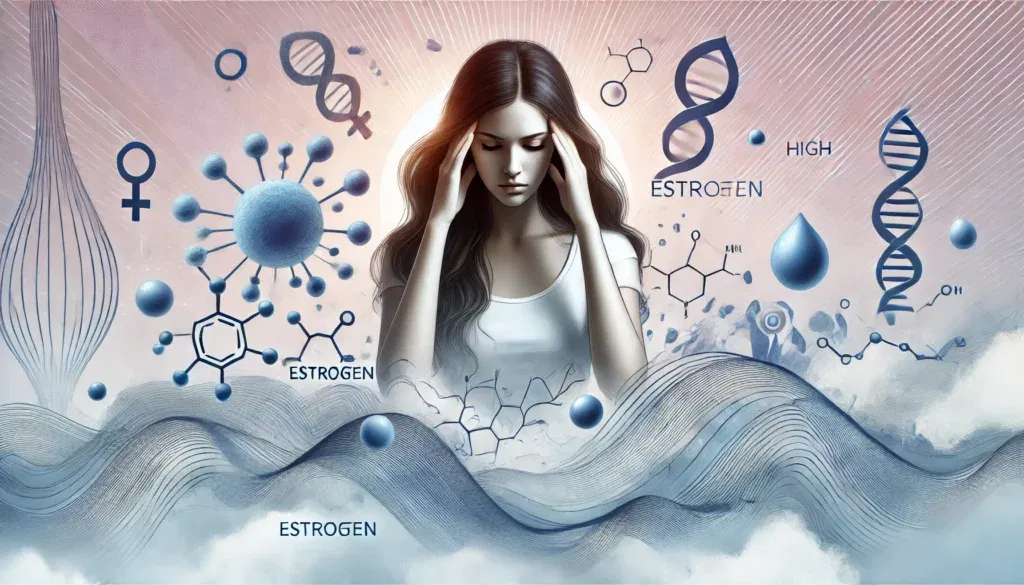Estrogen plays a fundamental role in regulating many aspects of a woman’s health, from reproductive function to cardiovascular well-being and even cognitive performance. However, an imbalance in estrogen levels, particularly an excess, can lead to a variety of health concerns. High estrogen, also known as estrogen dominance, can arise due to multiple factors, including lifestyle choices, environmental influences, and underlying medical conditions. Understanding the symptoms of high estrogen in women, recognizing potential causes, and exploring effective solutions are essential steps in restoring hormonal balance and promoting overall well-being.
You may also like: How to Get Your Testosterone Levels Checked: Best At-Home and Lab Testing Options
Understanding Estrogen and Its Role in Female Health
Estrogen is a group of hormones primarily produced in the ovaries, but it is also synthesized in smaller amounts by the adrenal glands and fat tissue. It is a key regulator of menstrual cycles, reproductive health, and secondary sexual characteristics. Beyond its reproductive function, estrogen influences bone density, cholesterol levels, mood regulation, and even skin health. Given its widespread impact, maintaining healthy estradiol levels is crucial for optimal functioning.
There are three main types of estrogen in the female body: estrone (E1), estradiol (E2), and estriol (E3). Estradiol is the most potent and abundant of the three, playing a central role in reproductive years. Normal estradiol levels fluctuate based on age, menstrual cycle phase, and menopausal status. Understanding estradiol range variations helps in identifying potential hormonal imbalances that could lead to high estrogen symptoms.

Common Symptoms of High Estrogen in Women
When estrogen levels become excessive relative to other hormones like progesterone, a variety of physical and emotional symptoms can emerge. One of the most noticeable signs of high estrogen in women is irregular menstrual cycles. Women may experience heavy bleeding, shorter cycles, or prolonged periods, which indicate disruptions in hormonal balance. These menstrual irregularities can significantly impact fertility and overall reproductive health.
Another common symptom of high estrogen is unexplained weight gain, particularly in the hips, thighs, and abdominal region. Estrogen promotes fat storage, and excess levels can lead to an increase in adipose tissue. This weight gain is often resistant to conventional diet and exercise efforts, making it a frustrating challenge for many women.
Mood swings, anxiety, and depression are also associated with elevated estrogen levels. Estrogen influences neurotransmitters like serotonin and dopamine, which regulate mood and emotional well-being. Excess estrogen can contribute to heightened stress responses, irritability, and a sense of emotional instability.
Breast tenderness and swelling can also be indicative of estrogen dominance. High estrogen levels lead to increased water retention in breast tissue, making them feel swollen and sore. This symptom is often more pronounced in the days leading up to menstruation and can be accompanied by fibrocystic breast changes.
Bloating and digestive issues are additional warning signs of high estrogen. Since estrogen plays a role in fluid retention and gut motility, an excess can result in bloating, constipation, and digestive discomfort. Women experiencing persistent gastrointestinal disturbances should consider evaluating their estrogen levels as a potential underlying cause.
Causes of High Estrogen in Women
Several factors contribute to elevated estrogen levels, ranging from natural hormonal fluctuations to external influences. One of the primary causes is estrogen dominance due to progesterone deficiency. Since progesterone counterbalances estrogen, a deficiency in this hormone allows estrogen to dominate, leading to imbalance and associated symptoms.
Environmental exposure to endocrine-disrupting chemicals (EDCs) is another major contributor to high estrogen levels. These chemicals, found in plastics, pesticides, cosmetics, and household products, mimic estrogen in the body and disrupt hormonal balance. Reducing exposure to EDCs by choosing natural, non-toxic alternatives can help mitigate their effects.
Obesity and excess body fat also play a role in estrogen elevation. Fat tissue produces estrogen, and higher levels of adipose tissue lead to increased estrogen synthesis. This creates a cycle where excess weight promotes estrogen dominance, which in turn contributes to further fat accumulation.
Chronic stress is another factor that can lead to high estrogen levels. Stress affects the adrenal glands, which produce cortisol and can disrupt the balance of sex hormones. Elevated cortisol levels can suppress progesterone production, creating an environment where estrogen becomes dominant.
Certain medications, including hormonal contraceptives and hormone replacement therapy (HRT), can also contribute to high estrogen levels. These medications introduce synthetic estrogens into the body, which may lead to imbalances if not properly regulated.
Effects of High Estrogen on Health
Prolonged exposure to high estrogen levels can have significant health implications. One of the most concerning effects is an increased risk of estrogen-related cancers, such as breast and endometrial cancer. Since estrogen promotes cell growth, excess levels can lead to the proliferation of abnormal cells, increasing cancer risk.
High estrogen is also linked to thyroid dysfunction. Estrogen influences thyroid hormone production and conversion, and excessive levels can contribute to hypothyroidism. Women with estrogen dominance often experience symptoms such as fatigue, weight gain, and cold intolerance due to impaired thyroid function.
Cardiovascular health can also be affected by elevated estrogen levels. While estrogen has protective effects on heart health in balanced amounts, excessive levels can increase the risk of blood clots, hypertension, and stroke. Women with estrogen dominance should monitor their cardiovascular markers and adopt lifestyle habits that support heart health.
Solutions for Balancing Estrogen Levels
Restoring hormonal balance requires a multi-faceted approach, including dietary adjustments, lifestyle changes, and, in some cases, medical interventions. One of the most effective ways to regulate estrogen levels is through diet. Consuming cruciferous vegetables such as broccoli, cauliflower, and Brussels sprouts helps the body metabolize and eliminate excess estrogen efficiently.
Incorporating fiber-rich foods like flaxseeds, chia seeds, and whole grains can also support estrogen detoxification by promoting healthy digestion and reducing estrogen reabsorption in the gut. Additionally, reducing alcohol and processed food consumption can help prevent estrogen accumulation.
Regular exercise plays a crucial role in hormone regulation. Engaging in strength training and cardiovascular activities helps maintain a healthy weight and reduces estrogen-producing fat tissue. Exercise also supports liver function, which is essential for estrogen metabolism and elimination.
Managing stress through mindfulness practices, meditation, and adequate sleep is another key strategy for balancing estrogen. Since chronic stress disrupts hormone levels, incorporating relaxation techniques can help support adrenal function and overall hormonal equilibrium.
For some women, medical interventions may be necessary. Consulting a healthcare provider to assess hormone levels through blood tests can provide valuable insights. If necessary, bioidentical hormone therapy or natural supplements like DIM (diindolylmethane) can be used to support estrogen balance under medical supervision.

Frequently Asked Questions (FAQ) on Estrogen and Hormonal Health
1. What are the lesser-known symptoms of high estrogen in women?
While many are familiar with common symptoms of high estrogen in women, such as bloating and mood swings, lesser-known signs include increased pigmentation, sensitivity to temperature changes, and prolonged headaches. Some women also experience heightened anxiety or sudden weight gain in the hips and thighs. Additionally, excessive estrogen can contribute to disrupted sleep cycles and fatigue, making it harder to maintain daily energy levels. Recognizing these symptoms early can help in seeking proper medical evaluation.
2. How do normal female hormone levels change with age?
Normal female hormone levels by age fluctuate significantly, especially during puberty, pregnancy, and menopause. Estradiol levels in women tend to peak in their reproductive years and begin declining in perimenopause, leading to symptoms such as night sweats and brain fog. The estradiol range for postmenopausal women is considerably lower compared to premenopausal levels. Tracking these changes using an estradiol levels chart can help in understanding hormonal health better. Consulting a healthcare provider is advisable for personalized hormonal assessments.
3. What happens if you have too much estrogen for an extended period?
Chronic high estrogen levels can lead to significant health risks, including an increased likelihood of blood clots, insulin resistance, and thyroid dysfunction. Prolonged exposure to elevated estrogen levels may also contribute to estrogen dominance, a condition linked to breast and uterine abnormalities. Additionally, excess estrogen may interfere with normal estradiol levels in females, leading to an imbalance with progesterone. Understanding what high estrogen means in the context of long-term health is essential for preventing complications.
4. What body parts produce estrogen, and how does this impact overall health?
Estrogen is primarily produced by the ovaries, but other organs such as the adrenal glands and fat tissue also contribute to its production. The liver plays a crucial role in metabolizing estrogen, ensuring that excess amounts are excreted efficiently. Additionally, the brain helps regulate estrogen production by signaling the ovaries through the hypothalamic-pituitary-gonadal axis. Since estrogen influences multiple bodily functions, from bone density to cardiovascular health, maintaining a balanced estradiol normal range is critical for overall well-being.
5. Where does estrogen come from besides the body’s natural production?
Apart from endogenous production, estrogen can enter the body through external sources, including certain foods, medications, and environmental chemicals. Phytoestrogens found in soy products mimic estrogen in the body, while synthetic estrogens in birth control pills directly impact hormone levels. Additionally, xenoestrogens—chemicals found in plastics, cosmetics, and pesticides—can interfere with normal estrogen levels in women. Understanding these sources helps in making lifestyle adjustments to maintain healthy estradiol levels.
6. How much estrogen does a woman have compared to other hormones?
The amount of estrogen a woman has fluctuates depending on age, menstrual cycle phase, and overall health. Estrogen is dominant in the first half of the menstrual cycle, whereas progesterone takes precedence in the second half. The estradiol normal value can range from 15 to 350 pg/mL in premenopausal women, but this drops significantly after menopause. Comparing estrogen levels to other hormones, such as progesterone and testosterone, can provide a clearer picture of hormonal balance.
7. How can diet influence healthy estradiol levels?
Diet plays a pivotal role in regulating estrogen levels, with certain foods either promoting or inhibiting estrogen metabolism. Cruciferous vegetables such as broccoli and cauliflower contain compounds that support the liver’s ability to break down excess estrogen. Fiber-rich foods help eliminate estrogen through digestion, preventing reabsorption into the bloodstream. Conversely, excessive intake of processed foods and alcohol can disrupt normal estradiol levels, making dietary choices crucial for hormonal health.
8. What is the connection between estrogen levels and mental health?
Estrogen directly impacts neurotransmitters such as serotonin and dopamine, which regulate mood and cognition. Women experiencing signs of high estrogen in women, such as anxiety and irritability, often report changes in emotional stability. Fluctuations in normal estrogen levels in women have also been linked to depressive symptoms, particularly during perimenopause. Maintaining balanced estrogen levels through lifestyle choices, stress management, and medical interventions can significantly improve mental well-being.
9. How do birth control pills affect estradiol range and hormone balance?
Hormonal contraceptives often contain synthetic estrogen, which can alter a woman’s natural estradiol levels in women. These pills suppress ovulation, leading to a more consistent but artificial hormone level throughout the cycle. Over time, this can affect the body’s ability to regulate its own estrogen production, sometimes leading to estrogen dominance after discontinuation. Understanding what should my estradiol level be in relation to hormonal contraceptives is essential for making informed decisions about birth control use.
10. What are the best natural ways to support balanced estrogen levels?
To maintain normal estradiol levels in females, incorporating lifestyle habits such as regular exercise, stress reduction, and a balanced diet is key. Physical activity helps metabolize excess estrogen, while stress management techniques such as meditation can prevent hormonal imbalances. Herbal supplements like maca root and chasteberry have been studied for their potential to regulate normal female hormone levels by age. Regular medical check-ups and hormone testing can also ensure that estrogen levels remain within a healthy range.

Conclusion: Taking Control of Estrogen Balance
Understanding the symptoms of high estrogen in women is the first step toward achieving hormonal balance and overall well-being. By recognizing the causes and effects of estrogen dominance, women can make informed decisions about their health. Implementing dietary and lifestyle changes, reducing exposure to endocrine disruptors, and seeking medical guidance when necessary are key strategies for maintaining optimal hormone levels. Achieving a balanced estrogen state not only enhances reproductive health but also promotes mental clarity, cardiovascular well-being, and long-term vitality. Prioritizing hormone health is an investment in overall quality of life, empowering women to feel their best at every stage of life.
high estrogen symptoms, estrogen dominance in women, female hormone imbalance, natural ways to balance estrogen, signs of hormonal imbalance, estrogen detoxification foods, causes of high estrogen, estrogen and weight gain, mood swings and estrogen, estrogen and thyroid health, estrogen dominance treatment, progesterone and estrogen balance, estrogen and cardiovascular risk, symptoms of too much estrogen, high estrogen and fertility, hormone testing for women, estrogen and digestive health, environmental estrogen exposure, estrogen metabolism support, reducing estrogen naturally
Further Reading:
What Happens if you Have High Estrogen or Low Estrogen?
What are the symptoms of high estrogen?
Signs and Symptoms of High Estrogen
Disclaimer: The information provided in this article is for general informational purposes only. The content does not constitute professional advice of any kind, including but not limited to medical, legal, or financial advice. HisHealthMag and its contributors make no representations or warranties regarding the accuracy, completeness, or reliability of the information presented. Always seek the advice of a qualified professional for any specific concerns or questions you may have. Neither HisHealthMag nor its authors assume any responsibility or liability for any actions taken based on the information provided in this article. The views and opinions expressed are those of the author(s) and do not necessarily reflect the official policy or position of HisHealthMag.





